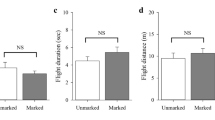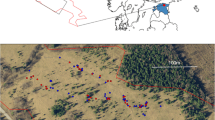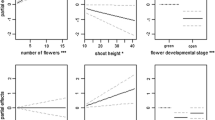Abstract
In insects, the selection of a suitable oviposition site is critical for offspring performance. Avoiding hosts already occupied by conspecific immatures in oviposition is one of the mechanisms to reduce intraspecific competition. The avoidance of such hosts by ovipositing females has been well-documented in parasitoid wasps and phytophagous insects but remains unknown in mycophagous insects. Here, we report that oviposition marks (OMs) of the fungus-farming lizard beetle, Doubledaya bucculenta (Coleoptera: Erotylidae: Languriinae), deter conspecific females from oviposition. The females excavate a wall of host bamboo internodes to access cavities for oviposition and plug the holes with excised bamboo fibers after oviposition. A larva completes its development within a single internode. To determine what types of OMs function as oviposition deterrents and how the oviposition-deterring pattern associates with offspring survival, we examined the oviposition behaviors, egg-period lengths, and reactions of larvae to eggs. When a single internode was provided, most females laid eggs in internodes with no OMs, incomplete OMs, or plug-removed completed OMs (COMs), but fewer females laid in internodes with fresh COMs and no females laid in those with old COMs. When eggs were reared under constant temperatures, egg-period lengths varied, suggesting that later-laid eggs sometimes hatch earlier than earlier-laid eggs. When a larva encountered an egg, all eggs were killed shortly. These results suggest that the females avoid internodes associated with high offspring mortality and that the COM’s plug contains an oviposition-deterring cue. Given that larvae of oviposition-deterring insects including D. bucculenta inhabit spatiotemporally-limited sites and have limited mobility, high resource competition in the larval stage may have driven the evolution of oviposition deterrence.



Similar content being viewed by others
References
Anbutsu H, Togashi K (2000) Deterred oviposition response of Monochamus alternatus (Coleoptera: Cerambycidae) to oviposition scars occupied by eggs. Agr Forest Entomol 2:217–223
Anbutsu H, Togashi K (2001) Oviposition deterrent by female reproductive gland secretion in Japanese pine sawyer, Monochamus alternatus. J Chem Ecol 27:1151–1161
Awmack CS, Leather SR (2002) Host plant quality and fecundity in herbivorous insects. Annu Rev Entomol 47:817–844
Dempster JP (1992) Evidence of an oviposition-deterring pheromone in the orange-tip butterfly, Anthocharis cardamines (L). Ecol Entomol 17:83–85
Ellsbury MM, Baker GT (1989) Biological and morphological aspects of the egg stage and oviposition of Languria mozardi (Coleoptera: Languriidae). Proc Entomol Soc Wash 91:9–14
Gauthier N, Monge JP, Huignard J (1996) Superparasitism and host discrimination in the solitary ectoparasitoid Dinarmus basalis. Entomol Exp Appl 79:91–99
Genung WG, Eoodruff RE, Grissell EE (1980) Languria erythrocephalus: Host plants, immature stages, parasites, and habits (Coleoptera: Languriidae). Fla Entomol 63:206–210
Hayashi N (1974) Ecology of Doubledaya bucculenta. Nat Insect 9:17 [In Japanese]
Japan Meteorological Agency (2020) Japan meteorological agency past weather data search. https://www.data.jma.go.jp/obd/stats/etrn/index.php. Accessed 13 July 2020 [In Japanese]
Kobayashi M (2017) The illustrated book of plant systematics in color: Bambusoideae in Japan. Hokuryukan, Tokyo [In Japanese]
Kumari A, Kaushik N (2016) Oviposition deterrents in herbivorous insects and their potential use in integrated pest management. Indian J Exp Biol 54:163–174
Kurtzman CP (2011) Wickerhamomyces Kurtzman, Robnett & Basehoar-Powers (2008). In: Kurtzman CP, Fell JW, Boekhout T (eds) The yeasts, a taxonomic study, vol 2, 5th edn. Elsevier, Amsterdam, pp 899–917
Leschen RAB, Buckley TR (2007) Multistate characters and diet shifts: evolution of Erotylidae (Coleoptera). Syst Biol 56:97–112
Mohamad R, Monge JP, Goubault M (2012) Wait or fight? Ownership asymmetry affects contest behaviors in a parasitoid wasp. Behav Ecol 23:1330–1337
Nufio CR, Papaj DR (2001) Host marking behavior in phytophagous insects and parasitoids. Entomol Exp Appl 99:273–293
R Core Team (2018) R: A language and environment for statistical computing. R Foundation for Statistical Computing, Vienna
Refsnider JM, Janzen FJ (2010) Putting eggs in one basket: ecological and evolutionary hypotheses for variation in oviposition-site choice. Annu Rev Ecol Evol Syst 41:39–57
Renwick JAA, Chew FS (1994) Oviposition behavior in Lepidoptera. Annu Rev Entomol 39:377–400
Roitberg BD, Prokopy RJ (1987) Insects that mark host plants. Bioscience 37:400–406
Schneider CA, Rasband WS, Eliceiri KW (2012) NIH Image to ImageJ: 25 years of image analysis. Nat Methods 9:671–675
Shimura T (2006) Insect larva of Japan, 2nd edn. Gakken, Tokyo [In Japanese]
Toki W (2009) New host plants and additional records of asymmetric lizard beetle Doubledaya bucculenta Lewis, 1884 (Coleoptera: Erotylidae: Languriinae) in distributional northernmost region. Biogeography 11:109–111
Toki W, Chiu MC, Huang CG, Wu WJ (2020) Larval host plants of two lizard beetles in the genus Tetraphala (Coleoptera, Erotylidae, Languriinae, Languriini) from Taiwan, with a host plant list of Languriini. Entomol Sci (in press)
Toki W, Hosoya T (2012) New host plant and southernmost records of asymmetric lizard beetle Doubledaya bucculenta Lewis (Coleoptera, Erotylidae, Languriinae). Elytra New Ser 1:253–254
Toki W, Matsuo S, Pham HT, Meleng P, Lee CY (2019) Heads or tails: exaggerated morphologies in relation to the use of large bamboo internodes in two lizard beetles, Doubledaya ruficollis and Oxylanguria acutipennis (Coleoptera: Erotylidae: Languriinae). Sci Nat 106:50
Toki W, Matsuo S, Pham HT, Yoshitomi H (2014) Morphology of adult and immature stages, and host plant use of Doubledaya sinuata (Coleoptera: Erotylidae: Languriinae). Acta Entomol Mus Nat Pragae 54:623–634
Toki W, Pham HT, Togashi K (2016) Relationship between mandibular asymmetry, oviposition hole, and oviposition substrate hardness in two bamboo-using lizard beetles Doubledaya tonkinensis and D. sinuata (Coleoptera: Erotylidae: Languriinae). Ann Entomol Soc Am 109:850–859
Toki W, Takahashi Y, Togashi K (2013) Fungal garden making inside bamboos by a non-social fungus-growing beetle. PLoS One 8:e79515
Toki W, Tanahashi M, Togashi K, Fukatsu T (2012) Fungal farming in a non-social beetle. PLoS One 7:e41893
Toki W, Togashi K (2011) Exaggerated asymmetric head morphology of female Doubledaya bucculenta (Coleoptera: Erotylidae: Languriinae) and ovipositional preference for bamboo internodes. Zool Sci 28:348–354
Toki W, Togashi K (2013) Relationship between oviposition site selection and mandibular asymmetry in two species of lizard beetles, Anadastus pulchelloides Nakane and Doubledaya bucculenta Lewis (Coleoptera: Erotylidae: Languriinae). Coleopt Bull 67:360–367
Wai KM, Fujii K (1990) Intraspecific larval competition among wasps parasitic of bean weevil larvae. Res Popul Ecol 32:85–98
Acknowledgments
We wish to thank Yuko Miyazaki for help with the field work, Hisashi Kajimura for providing literature-based information, and Naoya Miyajima and Genki Watanabe for helpful comments.
Availability of data and material
All datasets in current study are available from the corresponding author on reasonable request.
Code availability
Not applicable.
Funding
This study was supported by a KAKENHI Grant (18 K14473) from the Japan Society for the Promotion of Science (JSPS).
Author information
Authors and Affiliations
Contributions
All authors contributed to the study conception and design, material preparation, and writing of the manuscript. Data collection and analysis were performed by Yuta Miyazaki. All authors read and approved the final manuscript.
Corresponding author
Ethics declarations
Conflict of interest
The authors declare that they have no conflict of interest.
Ethics approval
All applicable international, national, and/or institutional guidelines for the care and use of animals were followed.
Consent to participate
Not applicable.
Consent for publication
Not applicable.
Additional information
Communicated by: Matthias Waltert
Publisher’s note
Springer Nature remains neutral with regard to jurisdictional claims in published maps and institutional affiliations.
Rights and permissions
About this article
Cite this article
Miyazaki, Y., Toki, W. Time-dependent oviposition deterrence by an oviposition mark in a fungus-farming lizard beetle. Sci Nat 107, 53 (2020). https://doi.org/10.1007/s00114-020-01710-0
Received:
Revised:
Accepted:
Published:
DOI: https://doi.org/10.1007/s00114-020-01710-0




